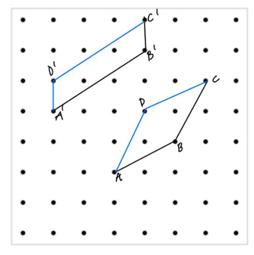
Personal Blogs
Why did the chicken cross the road?
The chicken didn't know either.
Consider the familiar square lattice. In principle it extends infinitely in every direction but the small patch below is enough to illustrate it. The distance between each point and its nearest neighbours could be anything, so let's just say it's 1 unit.

The question is whether we can embed a regular pentagon in this lattice so all its corners lie on lattice points. Is that possible? It could be any size and be slanted at any angle. Could a pentagon that fits the bill exist?
There's a clever but simple argument that shows the answer is no. Suppose we have three lattice points like for example ABC or A'B'C' in the next sketch.

We observe that points such as D or D' that make a parallelogram with the original three points must always be lattice points too.
Now suppose we have a regular pentagon with corners that are lattice points. Its size doesn't matter, we are only saying its corners are lattice points.

Draw in the diagonals of the pentagon.

From what we said earlier, given that ABC are lattice points and ABCD is a paralellogram, point D must also be a lattice point. Working our way round the pentagon we see that all five blue points must be lattice points by the same reasoning.
These points form a regular pentagon, and so we have found a smaller pentagon which has its corners on lattice points.
But now we can repeat the process and find a still smaller regular pentagon all of whose corners are lattice points. We can repeat this indefinitely often, each time obtaining smaller and smaller pentagons whose corners lie on lattice points.
However this cannot be; eventually the length of the pentagon's sides would have to be less than 1 unit which is impossible, because 1 is the minimum distance between any two lattice points.
This means that if we could embed a regular pentagon in the square lattice we could go on to achieve something impossible. So embedding the regular pentagon must have been impossible in the first place.
This is my slightly adapted and I hope very slightly simpler solution to a beautiful question I found on Burkard Polster's Mathologer YouTube channel. In 'What does this prove?' posted July 25 2020 he uses animations to explore a series of related impossibility proofs, and discusses the history of several related problems. In particular he draws on an lovely blog post http://jdh.hamkins.org/no-regular-polygons-in-the-integer-lattice/
Hyacinth!
Aloe Vera!
I swallowed some string. Now I have a sense of inner piece.
I love mange tout. I could eat them all up.
Persian cats don't care about the past. They live for the hair and meow.
The government have just been following the sirens.
A few days ago I described a problem my friend thought of. Suppose we have a street with 10 houses, each one the same distance from the adjacent houses.
![]()
A postman starts at No. 1 and in order to get plenty of exercise decides to visit each house exactly once and return to No. 1 at the end, in such a way that he walks the greatest possible distance. How can he do that, and what is the maxiumum distance?
There are 362800 possible routes he can take, and of those 2880 achieve the greatest possible distance, which is 50. If we divide the houses numbers into two groups, 1-5 and 6-10, then the longest path is any one that travels alternately back and forth between the first group and the second group, visiting each house just once and then returning to No. 1. For example
1, 6, 2, 7, 3, 8, 4, 9, 5, 10, 1
Rather surprisingly the distance is the same whatever order we visit the houses in each group.
The same scheme will give the longest path for any even number of houses. A similar scheme works for an odd number, although in this case we can't completely alternate between right and left; at some point the postman will have to go in the same direction twice running.
A version of this problem was published by Martin Gardner in Scientific American June 1965 and appeared before that in One hundred problems in elementary mathematics by Hugo Steinhaus.
Q. How would you measure greens?
A. With a greengage.
I found this goblet but sadly it leaks. Must be a holey grail.
They said I hadn’t paid my porridge bill. I told them I’d just have to oat.
As a protection against vampires, try combining celery, grapes, apple, walnuts and mayonnaise. I call this "ward off" salad.
A. Is this a silly question?
B. If it is, then this is a silly answer.
When I was 14 the oldest person I knew was Mr Smith. He lived in a tiny cottage, one room up and one down, with a scullery cum kitchen behind the ground floor. The cottage was on a sharp 80 degree angle between two streets, contributing to its miniscule size. Later it became a one-man barbershop, which shows how small it was.
I was assigned by my local community to visit Mr Smith. Our church, of which I was a reluctant member, had a scheme for sending volunteers to visit old people who might be lonely and Mr Smith was my assignment, to visit during the summer break from school. I don’t remember minding at all. They told me he was 93 and I was curious to meet him.
I was a bit scared when knocking on his door the first time but we instantly got on, in spite of the 79-year age gap. He was a good conversationalist and asked me about myself and what my ambitions were. I don’t know how well I answered.
This was in 1960 and he was then 93. So his birth date had been 1867. The American Civil War had ended only two years before.
In our weekly talks Mr Brown told me he had been a merchant seaman at the end of First World War and been part of a convoy that sailed to the far northern Russian port of Archangel. It was a hazardous run, with over 40 British merchant ships being lost between 1914 and 1918.
People in Archangel had given him simple presents. He showed me Easter breads – little buns stamped with a cross – and decorated wooden spoons, whose varnish had hardly dried in almost 50 years. I held and saw the past in my hands.
Mr Smith had been 47 when the First World War started. Think of it. At that point he was already too old to fight, although not too old to go to Archangel with the convoy.
When the summer holidays ended and my duty rota ceased I had good intentions to go and see him, but I was young and life beckoned. So I missed his going and I was sorry.
Q. Why is the Arrow of Time like the prize awarded to a chicken at a country fair?
A. Both are entropies.
This is something I've been thinking about recently. Why are there no oldspapers?
I’ve got so many alerts set up on my devices. A minute or so back I had one that said:
Tomorrow
Starting at 00:00
A couple of days ago an associate and friend who likes intriguing puzzles sent me this different take on the notorious Travelling Salesman Problem.
The original question is: given a collection of cities and all the travel distances between each pair, how can a travelling saleman plan a circular tour that is as short as possible? This is a hard problem, in the sense that when there are any substantial number of cities finding the best solution will bring any computer to its knees.
Although my friend is not a mathematician but a developmental psychologist, he had a mathematician's idea, one that follows one of George Pólya's heuristics: can you solve a simpler version of the problem?
So my friend asked himself, what if the cities are all in a line?
Imagine the cities are not cities, but houses on a street, assumed to be equally spaced out, and a mailman wants to minimise their walking distance. The solution is just to walk along the numbers in sequence 1, 2, 3... up to the last house number. Pretty obvious, huh?
And then he asked another good mathematical question, what if we varied the problem? So he asked for the longest path the mailman could take. Imagine they have a yen for exercise and want to walk as far as possible.
If we have 10 houses each 1 unit apart, what is longest route they could take to visit each house exactly once, and return to the end of the street where they started?
And what if there are n houses; can you find a formula?
Knock-knock!
Who’s there?
No it’s Jim.
"I'm counting how many pots of tea you make", said Tom brutally.
My girlfriend’s a geologist but she says I take her for granite.
"I adore the sound of church bells on a summer's evening", said Tom inspiringly.
numb
I could not feel the heat
eyeless
I could not see the flames
smell blind
I could not sense the smoke
deaf
I could not hear the flames
tasting fear
I was saved by that.
Yesterday I had a bad dream. I was an old mongrel dog, and they put me in a cur home.
This blog might contain posts that are only visible to logged-in users, or where only logged-in users can comment. If you have an account on the system, please log in for full access.
Total visits to this blog: 1959537